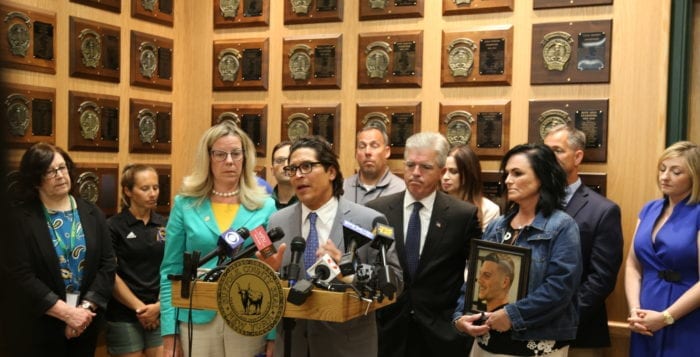By Rita J. Egan
On Saturday, May 18, the Smithtown Center for the Performing Arts debuted “Les Misérables School Edition,” and its only flaw is the title. With exceptionally talented teenagers and preteens, the production resembles that of a main-stage musical.

Based on the novel by Victor Hugo, with book by Alain Boublil, music by Claude-Michel Schonberg and lyrics by Herbert Kretzmer and Boublil, the musical digs into the depths of human nature. A myriad of emotions is explored from despair, fear and loathe to love, hope and forgiveness. The young actors in the Smithtown production have the skill and talent to take on the complex characters, and they seem to understand what drives them, which is essential when it comes to a classical musical such as this one.
“Les Misérables” opened in New York City in 1987 and ran until 2003, making it the fifth-longest show on Broadway. Two revivals on the Great White Way followed, one from 2006 to 2008 and another from 2014 to 2016.

Set in the early 19th century in France, “Les Misérables” follows Jean Valjean who is released from prison after serving 19 years for stealing a loaf of bread for his sister’s starving child. While Valjean at first feels hopeless for a second chance, the kindness of a bishop inspires him to break his parole and live a new life. While continually avoiding the wrath of police inspector Javert, Valjean goes on to become a successful factory owner, who grants the dying wish of Fantine by giving her daughter Cosette a better life. In later years, Valjean becomes a protective father who resists letting his daughter go as she falls in love with Marius, a young idealist and revolutionist.
In the Smithtown production, directed by Cara Brown, Luke Ferrari is outstanding as Valjean. He captures the former prisoner’s despair and anger earlier in the show and later in the play begins to soften as a more mature and paternal Valjean. His singing is flawless in every song, especially during “Bring Him Home” in the second act when he appeals to God to keep Marius safe.

Hunter Pszybylski is the perfect choice for Javert as he seems to portray the stern character with ease. The actor’s voice is mature beyond his years, and he knows how to command the spotlight, which is his during his solos “Stars” and “Soliloquy (Javert’s Suicide).”
Angelina Mercurio is wonderful as Fantine and delivers a heartbreaking solo with “I Dreamed a Dream,” and she and Ferrari sound incredible during “Come to Me (Fantine’s Death).” Zak Ketcham makes for a handsome Marius, and he proves to be another strong vocalist on all his songs including “Empty Chairs at Empty Tables” where he beautifully captures the heartbreak of surviving the tragedy of losing his friends at the barricades.
Aubrey Alvino also captures the heartbreak of Eponine’s experience as she yearns for Marius who only has eyes for Cosette. Her solo “On My Own” during the May 19 show was a tearjerker, and her duo with Ketcham “A Little Fall of Rain” was just as lovely.
 Leah Kelly is the naive Cosette, and her vocals are sweet and delightful, especially during “A Heart Full of Love.” Gabby Blum, who plays a young Cosette, performs a perfect “Castle on a Cloud.” Luke Hampson, as Thénardier, and Alexa Adler, as Madame Thénardier, are delightful as the greedy and crafty innkeeper and his wife. The pair play an essential role in the musical to provide some comedic relief, and both actors know how to garner a good number of chuckles from the audience.
Leah Kelly is the naive Cosette, and her vocals are sweet and delightful, especially during “A Heart Full of Love.” Gabby Blum, who plays a young Cosette, performs a perfect “Castle on a Cloud.” Luke Hampson, as Thénardier, and Alexa Adler, as Madame Thénardier, are delightful as the greedy and crafty innkeeper and his wife. The pair play an essential role in the musical to provide some comedic relief, and both actors know how to garner a good number of chuckles from the audience.
All of the cast members provide superb vocals and exceptional performances, which are front and center during numbers such as “At the End of the Day,” “ABC Cafe/Red and Black,” “Lovely Ladies,” “Drink With Me” and “Do You Hear the People Sing.” Everyone on stage and behind the scenes of “Les Misérables School Edition” should be proud of the production, and with this kind of young, local talent, the future looks bright for regional theater.
With only six performances left, the Smithtown Center for the Performing Arts, 2 East Main St., Smithtown will present “Les Misérables School Edition” through June 2. All tickets are $20. For more information, visit www.smithtownpac.org or call 631-724-3700.
All photos by Courtney Braun









 Pam Deford (incumbent)
Pam Deford (incumbent) Dan Tew (incumbent)
Dan Tew (incumbent)

























